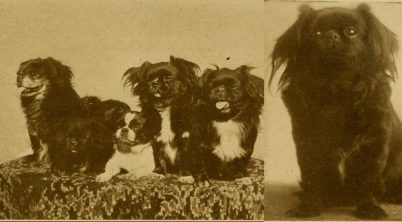Pekingese dogs are known for their distinctive flat faces and expressive eyes. However, their unique appearance comes with certain health considerations, particularly regarding their eye health. These dogs are prone to several eye issues, and eye discharge is a common symptom that Pekingese owners should be aware of. Eye discharge in Pekingese can vary in consistency from watery to pus-like and may be indicative of various underlying conditions.
Common eye problems that can cause discharge in Pekingese include dry eye, also known as keratoconjunctivitis sicca, where there is a lack of moisture in the eyes resulting in a thick discharge. Additional conditions include conjunctivitis, where the eye’s lining becomes inflamed, and corneal ulcers, which can result from untreated scratches or irritations. The breed’s distinctive facial structure, with their shallow eye sockets and short nasal passages, can exacerbate these issues, making them more susceptible to infections and other complications.
It is crucial for Pekingese owners to monitor their pets’ eye health diligently. Symptoms such as excessive tearing, redness, squinting or rubbing at the eyes could signal the onset of problems. Since the breed’s brachycephalic airway syndrome can also contribute to overall health issues that may affect the eyes, a comprehensive approach to their care, involving regular check-ups with a veterinarian, is essential for maintaining good eye health. Addressing any signs of eye discharge promptly can help prevent more serious complications and ensure the well-being of these beloved pets.
Table of Contents
Signs and Symptoms
When monitoring Pekingese for eye concerns, it’s essential to be cognizant of the common signs that may indicate eye problems. A vigilant observer can recognize the early symptoms and seek appropriate veterinary care.
Identifying Common Symptoms
Common symptoms of eye discharge in Pekingese can range from a clear, watery consistency to a thick, mucus-like secretion. Observers may note the following specific signs:
- Excessive Tearing: Tear overproduction that may wet the face.
- Discharge: Presence of a crust or mucus, which could be clear, yellowish, or green.
- Squinting or Blinking: Frequent squinting or increased rate of blinking.
- Redness: Visible reddening of the eye.
Recognizing Serious Eye Conditions
Serious eye conditions manifest through more alarming symptoms and can include:
- Conjunctivitis: Inflammation leading to red, itchy eyes with potential discharge.
- Entropion: A condition where the eyelid turns inward, causing irritation.
- Infections: Signs like pus-like discharge, often accompanied by odor.
- Blindness: Cloudiness in the eyes, which can be an indicator of loss of vision.
Understanding Pekingese-Specific Issues
Due to their unique facial structure, Pekingese dogs are predisposed to certain eye problems.
- Protruding Eyes: Making them more susceptible to injury and drying.
- Sensitivity to Light: Noticeable discomfort in bright environments.
- Rubbing or Pawing at Eyes: Indicative of discomfort or irritation.
- Allergies or Inflammation: May contribute to redness and tearing.
Potential Causes of Eye Discharge
Eye discharge in Pekingese can be attributed to a variety of factors, ranging from infections to genetic predisposition. This section explores the common causes that affect this breed.
Bacterial and Viral Infections
Pekingese may develop eye discharge due to bacterial infections like conjunctivitis, which inflames the membrane lining the eyelids. This condition often results in a thick, green or grey discharge. Viral infections, on the other hand, typically cause a watery discharge. In some instances, this discharge can lead to the eyes feeling stuck together.
Allergies and Environmental Factors
Allergic reactions to environmental irritants such as dust and pollen can induce eye discharge in Pekingese. The breed’s characteristic flat face and large eyes make them prone to irritation from airborne particles. Chronic issues like keratoconjunctivitis sicca, or dry eye, are also exacerbated by environmental factors.
Genetic Predisposition
Genetic factors play a significant role in the ocular health of Pekingese— a breed that falls under brachycephalic breeds. Their physical structure predisposes them to certain eye conditions, including corneal ulcers and trauma resulting from foreign bodies due to their protruding eyes. As a result, they are often at a higher risk for developing eye discharge.
Diagnosis and Veterinary Care
When a Pekingese presents with eye discharge, it is critical that they receive a thorough examination by a veterinarian to ensure a proper diagnosis and treatment plan. Eye issues in Pekingese can be indicative of underlying health conditions and accurate diagnosis is key to effective management.
Examining Pekingese Eye Health
Veterinarians will begin with a physical examination of the Pekingese’s eyes to identify any visible signs and symptoms, such as redness, squinting, or abnormal discharge. Veterinarians look for inflammation, keratitis (corneal inflammation), or any indications of trauma. The presence of pus in the discharge often suggests an infection, while a clear discharge might suggest allergies. Regular check-ups are recommended, as some eye conditions in Pekingese may develop gradually and can easily be missed without periodic examinations.
Diagnostic Tests and Procedures
To further investigate the cause of eye discharge, veterinarians may perform a series of diagnostic tests:
- Schirmer Tear Test: This test measures the eye’s tear production to determine if dry eyes may be causing the symptoms.
- Fluorescein Staining: This procedure helps to identify corneal ulcers or abrasions by revealing details invisible to the naked eye.
- Intraocular Pressure: Measurement of the pressure inside the eyes can help diagnose glaucoma.
If necessary, veterinarians might refer the Pekingese to an ophthalmologist for specialized care. Advanced diagnostic procedures like detailed imaging or eye biopsies may be employed for a conclusive diagnosis. Following these tests, a targeted treatment plan is developed, which may include medications such as topical antibiotics or surgery in more severe cases.
Treatment Options
The appropriate treatment for Pekingese eye discharge varies depending on the underlying cause, from medication to possible surgery, and requires regular home care.
Medications and Eye Drops
For infections such as conjunctivitis, veterinarians commonly prescribe antibiotics either as systemic medications or as ophthalmic ointments and eye drops. These treatments aim to reduce infection and mitigate symptoms. Sterile saline solution may be used to wash away discharge. In cases of discomfort or inflammation, anti-inflammatory drugs or pain medication may be recommended.
- Antibiotics: Systemic antibiotics or antibiotic eye drops.
- Anti-inflammatory drugs: To reduce inflammation and provide pain relief.
- Artificial tears: To lubricate the eyes and relieve symptoms of dryness.
Surgical Interventions
Surgical treatment may be required for structural problems contributing to eye discharge, such as ectropion (outward turning of the eyelid) or eyelid abnormalities like distichiasis. Surgeries aim to correct the anatomical issues that can lead to chronic irritation or infection.
- Correction of eyelid abnormalities: Surgery for conditions like ectropion.
- Removal of problematic lashes: Treatment for trichiasis and distichiasis.
- Cataract surgery: In cases where cataracts impair vision and contribute to eye problems.
Home Care and Prevention
Home care is crucial in managing eye conditions and includes routine cleaning with a sterile saline solution to remove eye discharge. Owners should regularly check their Pekingese’s eyes for signs of problems such as corneal abrasions or changes in appearance. Ensuring that facial folds are clean and dry can prevent irritation and infections around the eyes.
- Regular cleaning: Using a sterile solution to keep the eye area clean.
- Monitoring: Observing for early signs of eye problems and seeking veterinary care promptly.
Managing Eye Health in Pekingese
Pekingese dogs are genetically predisposed to a variety of eye issues, making vigilant eye care crucial to prevent infections and complications such as prolapse. Owners should focus on routine grooming, proper nutrition, and consistent veterinary oversight to maintain eye health.
Routine Grooming and Care
Cleanliness is vital in managing Pekingese eye health. Regularly cleaning the area around the eyes with a soft, damp cloth can prevent the buildup of discharge and reduce the risk of infections. Grooming should involve carefully trimming the hair to prevent irritation from kinked eyelashes or foreign particles like fleas, which can cause discomfort and excessive tearing. After grooming, an Elizabethan collar may be necessary to stop the dog from pawing at its eyes, avoiding additional irritation or injury.
Dietary Considerations
A balanced diet rich in Vitamin A supports overall eye health. Ensure the Pekingese’s meals contain the appropriate nutrients that aid in maintaining clear pupils and a strong cornea. Foods that are high in antioxidants can help combat environmental stress on the eyes. A diet suited to the specific needs of Pekingese can be established with veterinary guidance to prevent nutritional deficits that could exacerbate eye issues.
Regular Veterinary Checkups
Routine check-ups are imperative to detect early signs of eye issues in Pekingese dogs. Regular visits to the veterinarian allow for professional assessment of eye health and can lead to early detection of problems like prolapse, infections, or genetic conditions such as Progressive Retinal Atrophy. The vet can recommend or prescribe treatments to prevent eye infections and manage any existing complications. If eye problems are identified, following the vet’s treatment plan, which may include medications or surgery, is essential for the wellbeing of the dog’s eyes.








